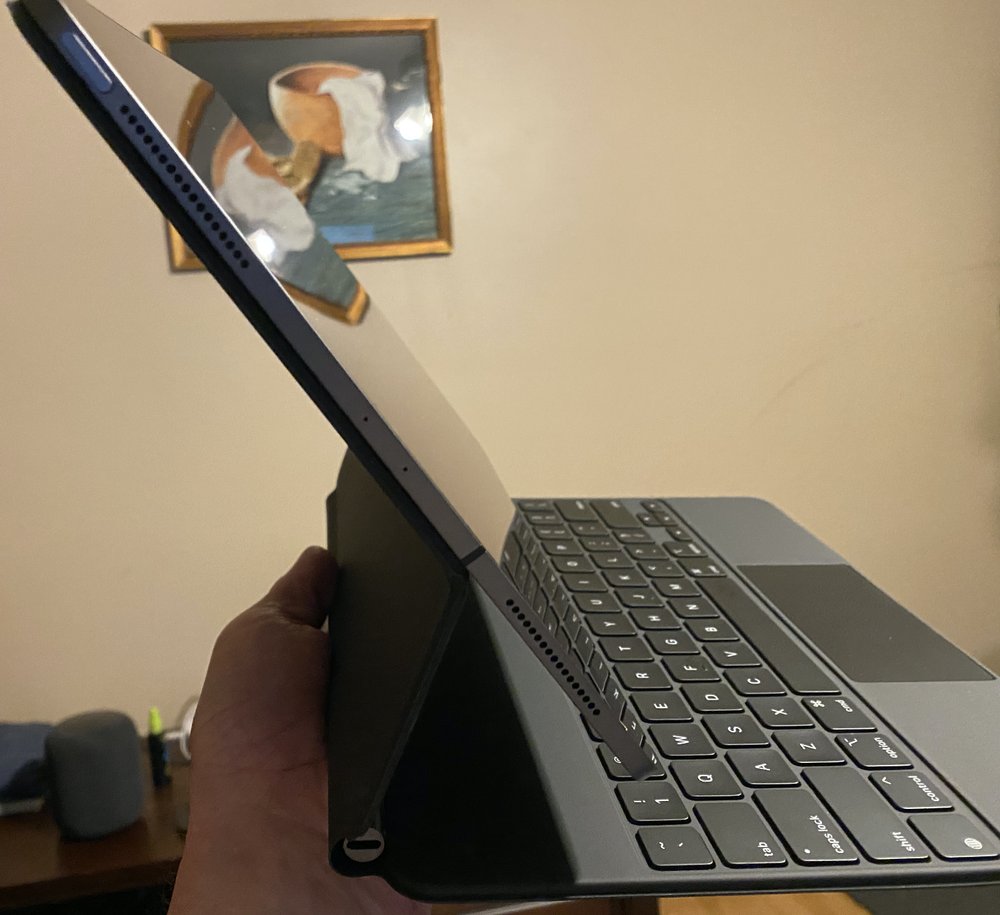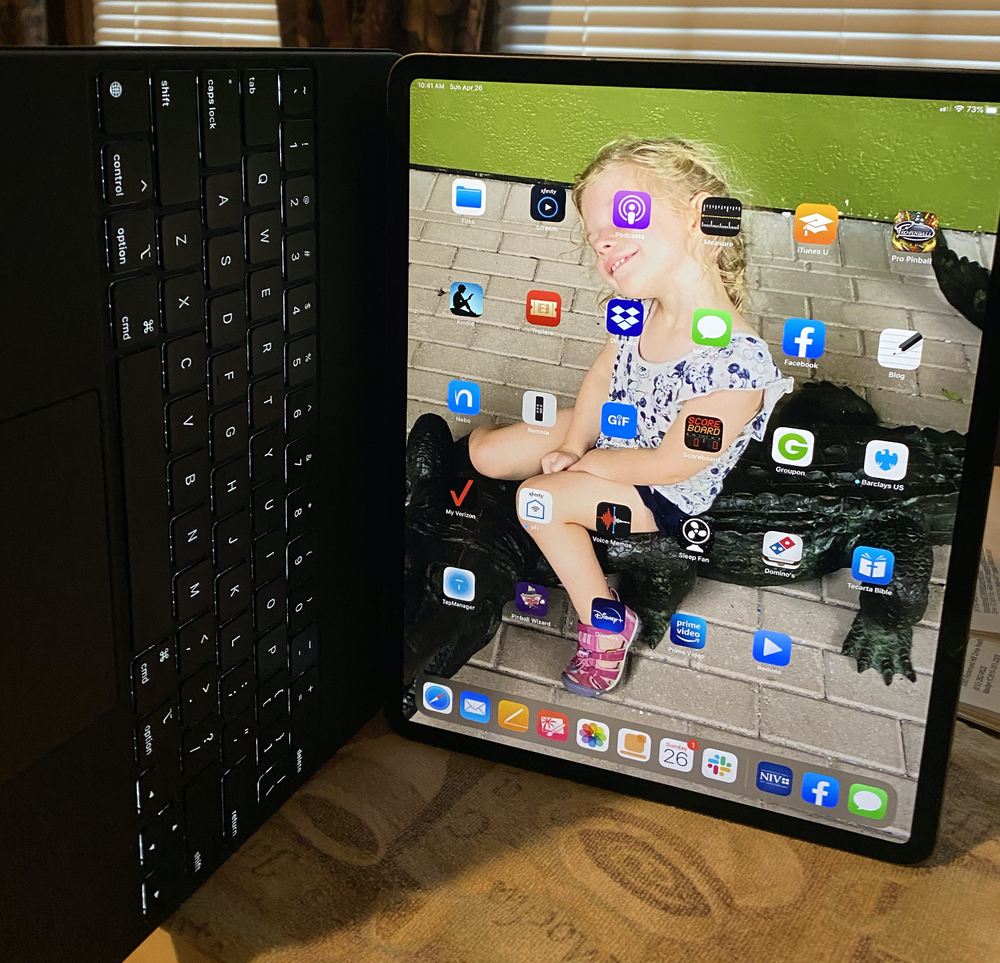I’ve been working with Apple’s Magic Keyboard for the 12.9-inch iPad Pro for several days. My consensus: if you wish to use the Apple tablet as a laptop replacement/alternative, it’s fantastic. If you use the iPad Pro as mainly….well….a tablet, save yourself some serious cash.

As a keyboard, it has almost everything I want. It attaches to the tablet magnetically, making the device’Multi-Touch screen available at viewing up to 130 degrees (more on that in a second). That’s thanks to the keyboard’s cantilevered design, which is where Apple’s “floating” analogy comes in.
The Magic Keyboard uses the iPad Pro’s Smart Connector, which works great. For example, the direct connection to the iPad means you don’t need to worry about charging the Magic Keyboard separately or pairing it via Bluetooth. (Why have only Apple and Logitech taken advantage of these connector?)
The keyboard is great for typing thanks to its scissor-switch mechanism, the same one that you’ll find on the 16-inch MacBook Pro and the latest MacBook Air. Theres a nice feel to the keys, which have good travel. The keyboard is backlit, which I really appreciate. What’s more, the keys automatically adjust based on the ambient lighting conditions, another nice (no pun intended) touch. (By the way, you can manually adjust the backlight settings by going to General >Hardware Keyboard.
On the downside, the Magic Keyboard lacks an Esc key. Nor does it have dedicated function keys for things such as music controls, volume, screen and keyboard brightness, etc., which would have added extra convenience.
The most outstanding feature of the Magic Keyboard is arguable the trackpad, which, thanks to the latest version of iPadOS, offers fluid navigation, easy cursor control, and precise adjustments.
iPadOS 13.4 brought trackpad support to iPad for the first time. Apple has designed the support specifically for this operating system instead of just porting it over from macOS. Designed specifically for the touch-first experience on an iPad, the cursor appears as a circle that highlights user interface elements, text fields, and apps on the Home screen and Dock, giving a clear indication of what you can click on. Fluid gestures on the trackpad make it easy to switch between apps, access the app switcher and activate the Dock, Control Center and apps in Slide Over.
It’s cool that the cursor transforms from a circle into other icons as it gets close to them. For example, on the Home screen the cursor disappears when you hover over various app icons, and the icons themselves became bigger. When you’re in a document, web page, or email, the cursor (at least with Pages, Safari, and Mail) becomes an I-beam for selecting text, and right-clicking works for copying text.

Despite all these nice features, I almost broke my Magic Keyboard when I first tried it. It has hardly any flex. It took my dim brain a while to figure this out, as I keep trying to force it to flex more. Thankfully, the Magic Keyboard is extremely rugged, so just laughed off my puny efforts. With it attached, it also offers protection for the iPad Pro
Of course, the lack of flexibility is due to the necessary balance required using it with your Apple tablet. Unlike using the Smart Keyboard or Smart Keyboard Folio, the tablet/Magic Keyboard combo balances well on your lap. The iPad Pro is also very securely attached; there are some seriously strong magnets in the keyboard.
But back to the ability of the screen to tilt. You can tilt the iPad screen from 90 to 130 degrees when it’s attached to the Magic Keyboard. That limited flexibility is, I assume, necessary for the aforementioned balancing act. However, it can indeed be “limited,” especially if you’re used to adjusting a laptop’s screen back.
With USB-C pass-through charging, the Magic Keyboard keeps the USB-C port on iPad Pro free for accessories, including external drives and displays. However, it doesn’t handle data transfer, so you’ll have to connect peripherals to the tablet’s USB-C port
Oh yes, Apple has added another nice touch: for added security, when the Magic Keyboard is attached and closed, the iPad Pro microphones are disconnected, preventing any audio data from being compromised.
However, all these nifty features of the Magic Keyboard come at a price in both money and weight. My 12.9-inch iPad Pro/Magic Keyboard combo weighs almost three pounds, while the tablet alone is only 1.42 pounds. Three pounds is the same weight as the 13-inch MacBook Pro and heavier than the new MacBook Air, which is 2.8 pounds.
There’s also the matter of sticker shock. The Magic Keyboard costs US$299 for the 11-inch iPad Pro model and $349 for the 12.9-inch iPad Pro version.
Another issue for some folks: using an iPad Pro attached to the Magic Keyboard in a vertical position isn’t feasible. It’s not impossible, but it’s very awkward. For, say, reading a book, you’ll want to remove the tablet from the keyboard.

This boils down to the question, “Should I buy a Magic Keyboard?” The answer is: if you’re going to be doing a lot of word processing on your iPad Pro, it’s worth the steep price and gets the tablet very close to the functionality of a Mac laptop (iPadOS, despite its big steps forward is still more limiting than macOS). However, if you use the iPad mainly as a tablet with only a little typing occasionally, you can save some moolah by buying Apple’s Smart Keyboard Folio ($179) or Smart Keyboard ($159) instead.
Apple World Today Rating (out of 5 stars): ★★★★
